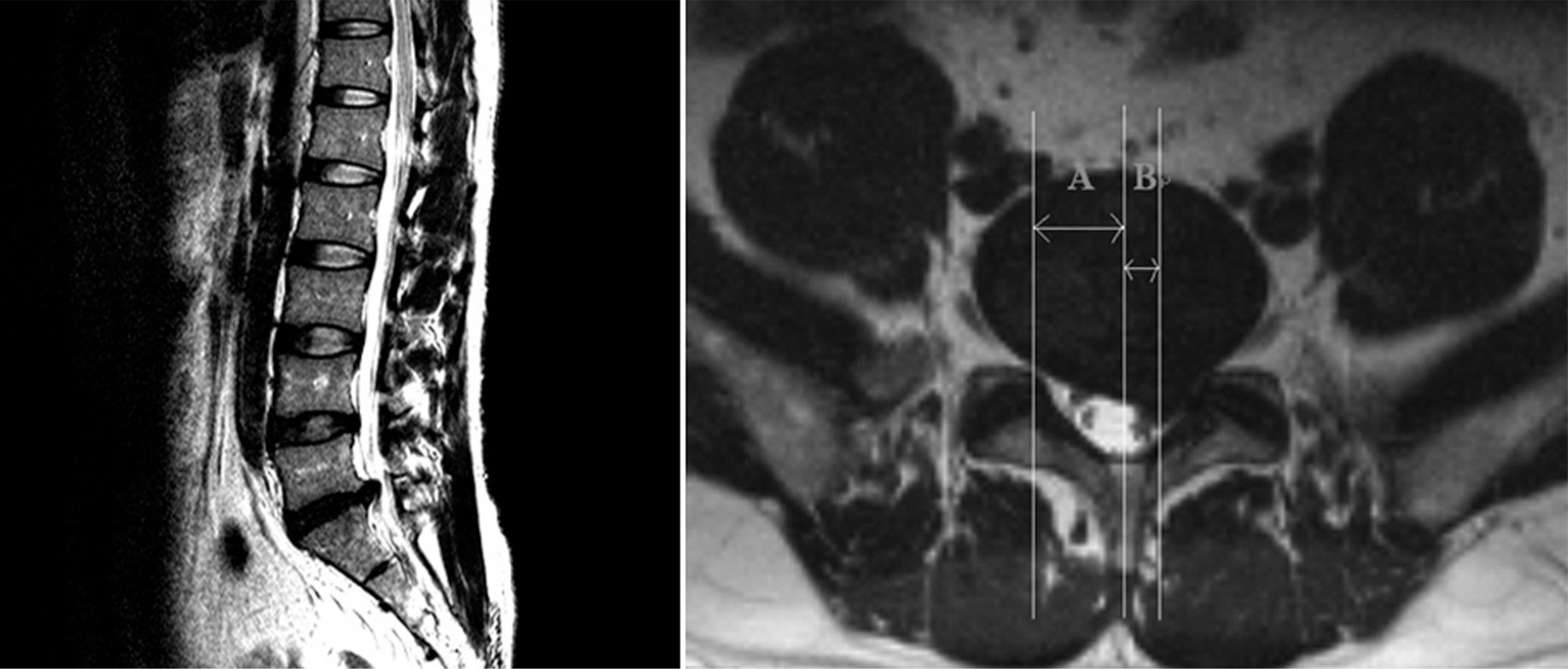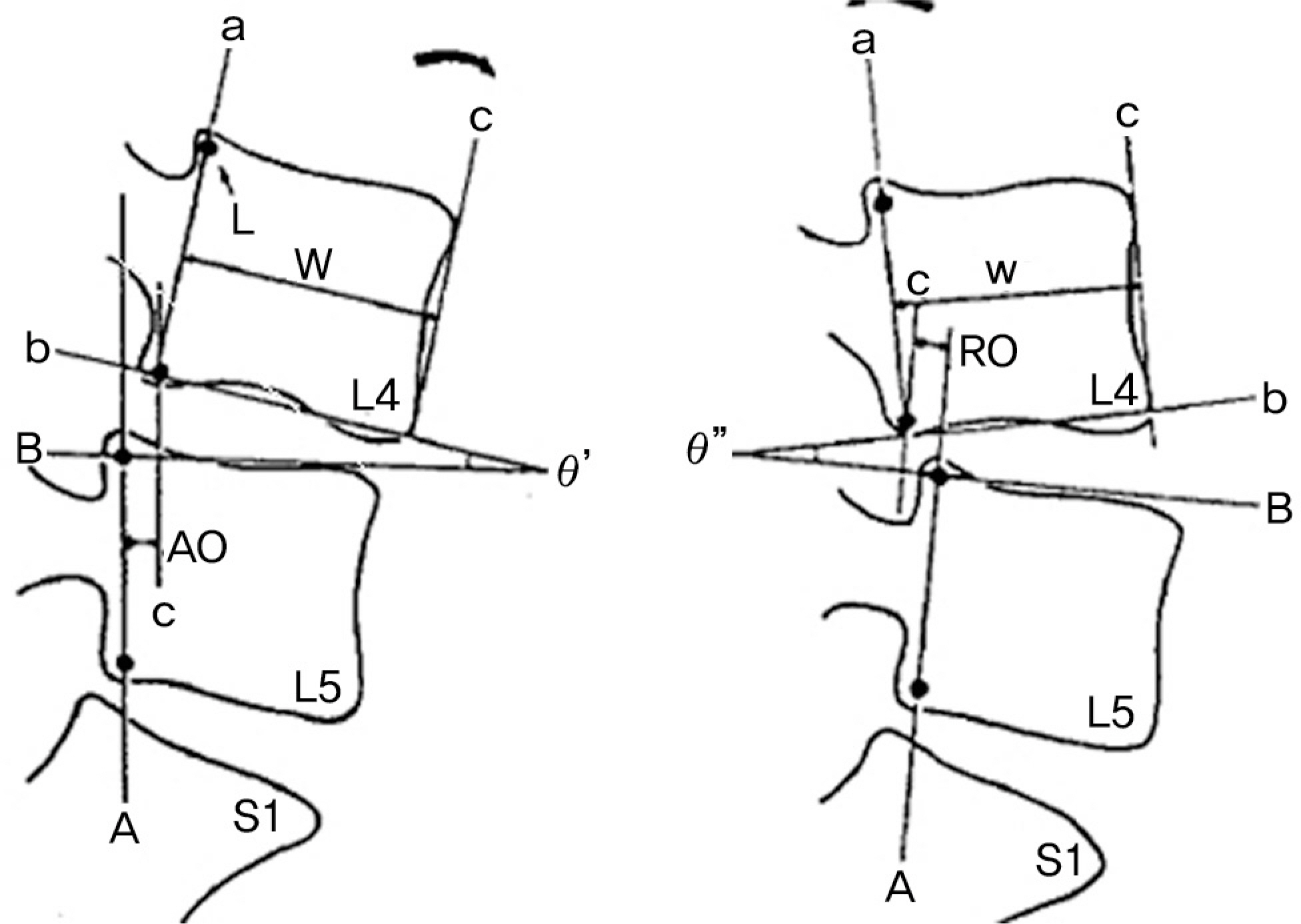J Korean Soc Spine Surg.
2010 Dec;17(4):169-176. 10.4184/jkss.2010.17.4.169.
Radiological and Clinical Outcome after Simple Discectomy of Central Massive Lumbar Disc Herniation
- Affiliations
-
- 1Department of Orthopedic, Surgery School of Medicine, Ewha Womans University, Seoul, Korea. oskdj@ewah.ac.kr
- KMID: 2209579
- DOI: http://doi.org/10.4184/jkss.2010.17.4.169
Abstract
- STUDY DESIGN: This is a retrospective case control study.
OBJECTIVES
To analyze our results following simple discectomy of central massive disc herniation focusing on instability for the usefulness of intervertebral fusion. SUMMARY OF LITERATURE REVIEW: Lumbar instability is a complication of central massive disc herniation. However, there is limited evidence on the correlation between lumbar instability and loss of disc material.
MATERIALS AND METHODS
A total of 25 patients who had undergone discectomy for a single-level lumbar disc herniation were followed up for two years. The clinical group (group A) included 12 patients that had a compromised canal with greater than 50% of the herniated disc, while the central axis of the herniated disc was less than 20% deviated from the center axis of the spinal canal, as seen on MRI. The control group (group B) had 13 patients that had a compromised canal with less than 50% of the herniated disc while their axis was more than 20% deviated from the center axis of the spinal canal. Clinical and radiologic instability, pain and functional disability were compared between the two groups.
RESULTS
No differences was found between the two groups in clinical instability, radiological instability, visual analogue scale (VAS), and the Oswestry disability index (ODI).
CONCLUSIONS
Central massive disc herniation after discectomy did not show a significant difference in clinical or radiological instability from that of other herniation types.
MeSH Terms
Figure
Reference
-
1.Knutsson F. The instability associated with disk degeneration of the lumbar spine. Acta Radiol Scand. 1944. 25:593–609.2.Dupis PR., Yong-Hing K., Cassidy JD., Kirkaldy Willis WH. Radiologic diagnosis of lumbar spinal instability. Spine. 1985. 10:262–76.3.Nachlas IW. End-results study of the treatment of herniated nucleus pulposus by excision with fusion and without fusion. J Bone Joint Surg Am. 1952. 34:981–8.4.Barr JS., Kubik GS., Molloy MK, et al. Evaluation of end results in treatment of ruptured lumbar intervertebral discs with protrusion of nucleus pulposus. Surg Gynecol Obstet. 1967. 125:250–6.5.Frymoyer JW., Hanley E., Howe J., Kuhlmann D., Matteri R. Disc excision and spine fusion in the management of lumbar disc disease: A minimum ten-year follow-up. Spine. 1978. 3:1–6.6.LaMont RL., Morawa LG., Pederson HE. Comparison of disc excision with combined disc excision and spinal fusion for lumbar disc ruptures. Clin Orthop. 1976. 121:212–6.7.Rish BL. A comparative evaluation of posterior lumbar interbody fusion for disc disease. Spine. 1985. 10:855–7.
Article8.Vaughan PA., Malcolm BW., Maistelli GL. Results of L4–L5 disc excision alone versus disc excision and fusion. Spine. 1988. 13:690–5.
Article9.Young HH., Love GJ. End results of removal of protruded lumbar intervertebral discs with and without fusion. Am Acad Orthop Surg Inst Course Lecture. 1959. 16:213–6.10.Takeshima T., Kambara K., Miyata S., Ueda Y., Tamai S. Clinical and radiographic evaluation of disc excision for lumbar disc herniation with and without posterolateral fusion. Spine. 2000. 25:450–6.
Article11.Satoh I., Yonenobu K., Hosono N., Ohwada T., Fuji T., Yoshikawa H. Indication of posterior lumbar interbody fusion for lumbar disc herniation. J Spinal Disord Tech. 2006. 19:104–8.
Article12.Tominaga S., Date K., Ouchi K, et al. Comparison between nonfusion and fusion group for lumbar discopathy—Effects of intervertebral fusion. Rinshou Seikei Geka. 1988. 23:236–46.13.White AH., von Rogov P., Zucherman J., Heiden D. Lumbar laminectomy for herniated disc; a prospective controlled comparison with internal fixationfusion. Spine. 1987. 12:305–7.14.Eie N. Comparison of the results in patients operated upon for ruptured lumbar discs with and without spinal fusion. Acta Neurochir (Wien). 1978. 41:107–13.
Article15.Barr JS. Low back and sciatic pain: Result of treatment. J Bone Joint Surg Am. 1951. 33:633–49.16.Burns BH., Young RH. Results of surgery in sciatica and low back pain. Lancet. 1951. 257:245–9.
Article17.Decker HG., Shapiro SW. Herniated lumbar intervertebral disks; results of surgical treatment without the routine use of spinal fusion. AMA Arch Surg. 1957. 75:77–84.18.Frymoyer JW., Hanley EN Jr., Howe J., Kuhlmann D., Matteri RE. A comparison of radiographic findings in fusion and nonfusion patients ten or more years following lumbar disc surgery. Spine. 1979. 4:435–40.
Article19.Weber H. Lumbar disc herniation: a controlled, prospective study with ten years of observation. Spine. 1983. 8:131–40.
Article20.GL Cribb, DC Jaffray, VN Cassar pullicino. Observation on the natural history of massive lumbar disc herniation. J Bone Joint Surg Br. 2007. 89:782–4.21.Barlocher CB., Krauss JK., Seiler RW. Central lumbar disc herniation. Acta Neurochir (wien). 2000. 142:1369–75.22.Knop-Jergas BM., Zucherman JF., Hsu KY., DeLong B. Anatomic position of a herniated nucleus pulposus predicts the outcome of lumbar discectomy. J Spinal Disord. 1996. 9:246–50.
Article23.Walker JL., Schulak D., Murtagh R. Midline disc herniation of the lumbar spine. Southern Med J. 1993. 86:13–7.24.Ki SC., Choi YS., Kim KS., Kuk WJ. Lumbar Discectomy Using Tubular Retractor and Microendoscopy. J Korean Soc Spine Surg. 2008. 15:265–71.
Article25.Chung YK., Yoo JH., Chung KJ., Wang JS. Clinical results of percutaneous endoscopic discectomy in herniated intervertebral disc of lumbar spine. J Korean Soc Spine Surg. 2005. 12:224–8.
Article26.Lee KY., Sohn SK., Lee MJ., Chung IK. The influence of the degree of lumbar disc degeneration on MRI and the amount of removed disc on clinical outcomes. J Korean Soc Spine Surg. 2005. 12:184–91.
Article
- Full Text Links
- Actions
-
Cited
- CITED
-
- Close
- Share
- Similar articles
-
- Clinical Outcome of Simple Discectomy for Recurrent Lumbar Disc Herniation
- Clinical and Radiological Findings of Nerve Root Herniation after Discectomy of Lumbar Disc Herniation
- Clinical Outcome and Influencing Factor for Repeat Lumbar Discectomy for Ipsilateral Recurrent Lumbar Disc Herniation
- Percutaneous Endoscopic Lumbar Discectomy (PELD)
- Safe Extraforaminal Docking and Floating Technique in Transforaminal Endoscopic Discectomy for Thoracolumbar Junction for Calcified Disc Herniation: A Case Report and Technical Review Junction for Calcified Disc Herniation




